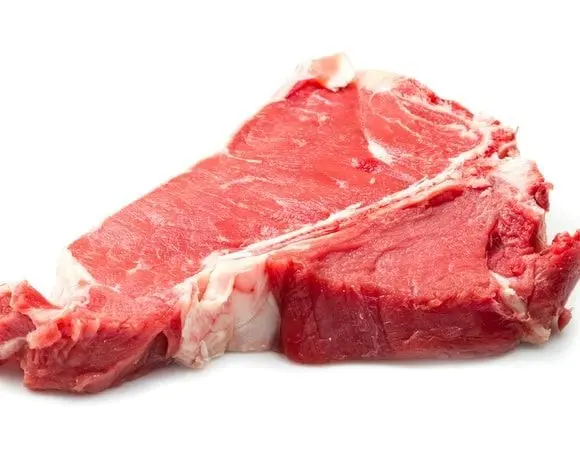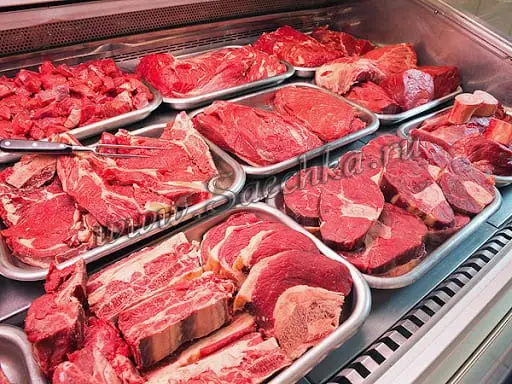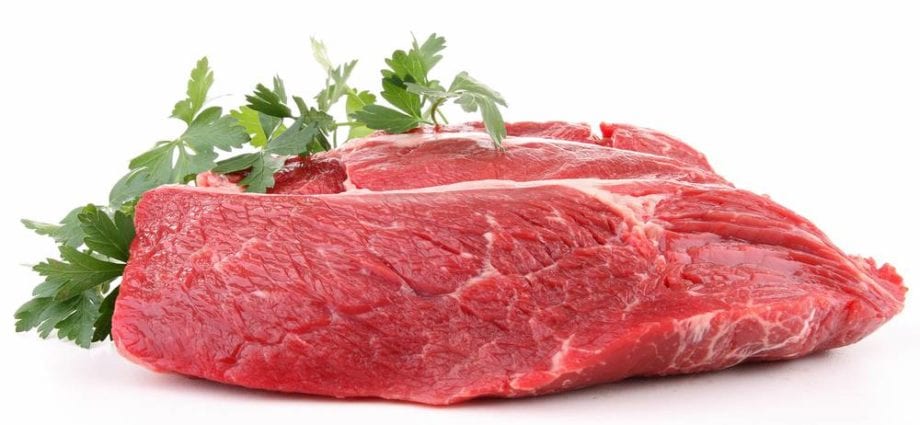Contents
Description
Beef is one of the first types of meat that is introduced into the diet of babies with the start of complementary foods. Beef broth is the best remedy after serious illness. This type of meat has many useful properties, but there are also a number of contraindications. Find out everything right now! And at the end there are 10 tips for choosing and cooking beef!
Beef is a great type of meat that contains few calories and many nutrients. It is advised to include it in your diet for athletes and anyone who follows a diet or has problems with immunity.
There are three types of beef: superior, first and second. The highest grade is the sirloin, meat from the back and chest. It is usually the juiciest and the least fiber. The first grade is meat from the neck, flank, shoulders and shoulder blades. Second grade – fore and hind tibia, cut.
They differ from each other in taste, meat structure (the highest grade is the most tender), juiciness. The variety of beef affects the amount of vitamins and nutrients, although their overall composition remains generally the same.
Beef is also distinguished by the breed of animal. So, marbled beef is appreciated all over the world – a real delicacy that really looks like a marble stone. This effect is created by thin layers of fat, which, when cooked, make the meat surprisingly juicy and tender. In order to obtain marbled beef, bulls are raised according to special technologies: the animals are intensively fed, and before slaughter, only grain remains in their diet, and they are also limited in movement.
Marbled beef is subdivided into several types depending on animal breeds and feeding methods. Japanese kobe beef, which is grown in Hyogo Prefecture in Japan, has become world famous and insanely expensive. It is made from the meat of young gobies who are fed rice, watered with beer and massaged with special brushes.

Beef composition
- Calorie content 106 kcal
- Proteins 20.2 g
- Fat 2.8 g
- Carbohydrates 0 g
- Dietary fiber 0 g
- Water 76 g
Beef, tenderloin is rich in vitamins and minerals such as: vitamin B2 – 12.8%, choline – 14%, vitamin B5 – 12%, vitamin B6 – 21%, vitamin B12 – 100%, vitamin PP – 28.5%, potassium – 13.7%, phosphorus – 26.4%, iron – 13.9%, cobalt – 70%, copper – 18.2%, molybdenum – 16.6%, chromium – 16.4%, zinc – 27 %
The benefits of beef for the body
- low calorie content and high nutritional value: easily absorbed after a long illness, facilitates the postoperative period;
- low fat content: minimal stress on the liver, kidneys and cardiovascular system;
- speeds up metabolism: great for those who are on a diet;
- easily digestible protein: useful for young children and the elderly;
- a unique set of useful elements: strengthens the nervous system, improves sleep, relieves insomnia, stimulates brain activity;
- vitamin E: helps to maintain youth and beauty;
- iron in its natural form: promotes hematopoiesis, fights anemia, fatigue, weakness, low efficiency;
- a combination of vitamins: strengthens teeth, nails, hair, skin, improves immunity;
- the most natural proportion of vitamins and microelements: beef dishes allow you to maintain a normal level of acidity in the stomach, normalize the acid balance in gastritis.
- Regular, but not excessive consumption of beef helps to eliminate “bad” cholesterol, strengthens blood vessels and becomes an excellent prevention of atherosclerosis;

Benefits of beef for men
The high nutritional value of beef with an almost complete absence of fat makes it an indispensable product for men who are actively involved in sports. The iron, amino acids and zinc contained in this meat contribute to the enrichment of cells with oxygen, increase testosterone levels, and improve potency.
Benefits of beef for women
The main advantage of beef over other types of meat, of course, is its low calorie content, ideal for those on a diet. In addition, beef contains a set of amino acids, vitamins, micro- and macroelements, which helps to maintain the health of hair, nails and skin. The high iron content helps to avoid anemia during pregnancy and is indispensable for recovery from childbirth. Beef dishes can be eaten even by those mothers who have dietary restrictions while breastfeeding.
Benefits of beef for children
Braised or boiled beef is the basis of the children’s menu. It contains: easily digestible protein, which is the best building material for tissues, vitamin A helps to strengthen the eye muscles, phosphorus and calcium are useful to avoid rickets. In addition, the high nutritional value of steamed beef helps to quickly and properly feed “little ones”.
Beef, especially obtained from properly raised animals, has three important advantages: it does not cause allergies, it quickly satiates, and is rich in all the elements necessary for the human body.
The harm of beef

Meat products often have contraindications. Beef is no exception, which can be not only useful, but also harmful. Excessive consumption of this type of meat can have the following negative consequences:
- digestive problems associated with abnormalities in the liver, kidneys, pancreas or stomach;
- the formation of cholesterol plaques in the vessels, which can lead to disruption of the myocardium;
- osteochondrosis, developing against the background of a decrease in vascular tone;
- general decrease in immunity due to deterioration of vascular patency;
- stagnation in the intestines can cause the deposition of uric acid salts, the development of diseases of the joints and the musculoskeletal system;
- increased risk of developing cancer of the esophagus or intestines.
- Also, beef is not indicated for patients during an exacerbation of pancreatitis and gastritis.
A poor-quality product obtained from unhealthy animals raised in unnatural conditions can cause hormonal disruptions and the development of human immunity to antibiotics.
How long beef can you eat
Beef is an extremely healthy product only if it is used correctly. It should be remembered that meat products should not make up more than 30% of an adult’s weekly menu.
Nutritionists believe that the benefits and harms of beef can be controlled by eating no more than 150 grams per meal (for children – no more than 80 grams), and the total amount should not be more than 500 grams. Beef dishes are recommended to be included in the menu 3-4 times a week.
10 tips for choosing the right beef

- the most correct decision would be to buy meat on the market or on a farm, in the village beef the beneficial properties are preserved in their natural form;
- do not buy frozen meat;
- choose pieces of rich color, without blotches; a brown tint is a sign of stale meat from an old animal;
- light beef fat, yellow tint of fat indicates that the meat is stale on the shelf;
- never buy beef that is bloody or wet;
- there should be no spots and crusts on the surface of the meat;
- the beef should be elastic: when pressed, the fibers should immediately level out;
- pay attention to the smell – it should be fresh, pleasant;
- it will be good to find out what the animal ate, because the most useful meat is obtained if it is fed with natural food on free grazing;
- choose veal for baby food, and meat of young animals for steaks, which already has fat layers, but has not become tough.
10 tips on how to cook beef properly

- If you do not plan to use the whole piece for the dish at once, do not wash it before freezing: this way you can keep the meat fresh for longer.
- The nutritional value of beef can vary depending on the cooking method. Most of the vitamins and useful elements are stored in boiled or stewed beef.
- The beef is cut along the grain. This will allow the meat to soak in the juices and prevent it from becoming dry and tough.
- If you are planning to fry beef, be sure to dry it with a towel so that the meat is evenly fried, securely “sealing” all its useful elements inside.
- Do not add salt to the beef right away – the salt helps the meat to juice out, and the dish will be dry.
- If the meat is too tough, soak it briefly in diluted vinegar.
- To keep the meat juicy during frying, start frying over high heat, and then reduce the heat intensity.
- Lingonberry or cranberry jam will be an excellent decoration for a beef dish, which will make the taste of the meat richer, and will also help to increase the secretion of gastric juice.
For baking beef, it is better to use foil, which will not allow moisture to evaporate, and the meat will remain juicy.
Be sure to serve beef dishes with vegetables and herbs. This promotes better absorption of vitamins and minerals, and also enhances the activity of the digestive tract.
Beef with garlic and wine sauce

Ingredients
- 10 cloves of garlic;
- 400 ml of red wine;
- 250 ml beef broth (you can use a cube);
- 1 tablespoon corn or potato starch
- 2 tablespoons of water;
- 1.3–1.6 kg of boneless beef (sirloin, sirloin, rump);
- pepper and salt to taste;
- 1 tablespoon olive oil
Preparation
- Cut each garlic clove into three pieces.
- Boil wine and broth, reduce heat. Dissolve the starch in water and add to the broth. Stir quickly until thickened. Leave the sauce until ready to serve.
- Leave defrosted or chilled beef at room temperature for 15–20 minutes before cooking. Make 8-10 small cuts on the piece with the tip of a sharp knife and place the garlic inside.
- Pat dry the meat with paper towels. Rub with pepper, salt and oil. Wrap the meat with the culinary thread across, leaving gaps of about 6–8 cm – this way the piece will retain its shape and the finished dish will be juicier.
- Place on a wire rack with the fat side on top. Place a regular baking sheet one level lower in the oven to drain the fat.
- Cook the meat for 30 minutes at 190 ° C. Then reduce the power to 100 ° C and leave it in the oven for another 1.5–2 hours. The thinner the piece, the faster it will bake.
Remove the cooked beef from the oven, cover with foil and leave for 20-30 minutes. Then slice and serve with wine sauce.










